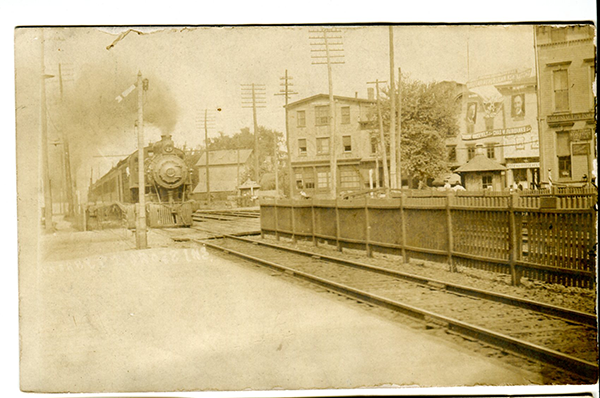
(above) Rahway Station as it look 1913-1974.
Railroad Played Large Part in Rahway Growth
The writer of an article outlining the history and development of the railroad through Rahway that appeared in the 125thanniversary issue of the Rahway News Record (May 27, 1948), stated, “It is safe to say at this late date that as the railroad went, so did Rahway.” Tracing the city’s history, there can be little doubt that since the tracks were laid in 1831 the railroad has influenced and continues to influence the growth of the city.
From Rahway’s early days until the third decade of the 1800s, the main arteries for transportation and commerce were the river and St. Georges Avenue. The river was a direct route to the Arthur Kill and provided power for a variety of mills located on the waterway. St. Georges Avenue was a main road connecting New York City and Philadelphia. After the Revolutionary War, shops, homes, hotels, a church, and offices dotted St. Georges Avenue making that stretch the “business district” for the area. By the mid-1830s, however, with the coming of the railroad, reliance on the river and the road lessened, shifting the commercial center to the Main Street/Irving Street side of town and to the properties all along the railways.
The New Jersey Railroad and Transportation Company began laying tracks for a main line between New York and Philadelphia in 1831 and by January 1832 stops were being made in Rahway. A wooden passenger depot would be built in close proximity to where the present station stands. The new transportation system immediately stimulated growth and prosperity in a number of ways. Rahway’s carriage trade grew into a major industry becoming one of the largest carriage manufacturing centers in the world. No longer was the river the only option for the exportation of vehicles and parts. All sorts of businesses and institutions including markets, barber shops, banks, drug stores, tailor shops, churches, laundries, jewelry stores, and saloons sprung up on Main, Irving, and Cherry Streets. The railroad also brought the city to the attention of those travelling the rails. Rahway Station was the first suburban stop after leaving New York City and many would come to find Rahway to be a convenient and pleasant place to live. Records also reveal that a large percentage of Rahway’s population was employed by the railroad. Engineers, firemen, freight and passenger crews, and maintenance workers were all needed to support the system.
The railroad also grew and made improvements over the years. In 1846 the Pennsylvania Railroad acquired the New Jersey Railroad and Transportation Company and would run the lines until 1968. It was because the mighty Penn Railroad, an organization that by 1882 had become the largest railroad, largest transportation enterprise, and largest corporation in the world, ran through the city that large industrial concerns would choose to make Rahway their home. Over the course of 100 years, from 1880-1980, major industries including Regina, Three-in-One Oil, Quinn and Boden, Wheatena, Royal Manufacturing, Merck, National Pneumatic, Monti Christi, Purolater, and Allen Industries built their complexes on the line. A second passenger station was even built off Scott Avenue to accommodate the employees from several plants.
Trains running on ground level had always been a hazard for vehicles and pedestrians and by the early 1900s the safety concern was finally addressed. To eliminate the dangerous situation of high speed trains crossing roadways, a major project of elevating the tracks commenced in December 1911. The first stage was to construct a new elevation on the eastern side of the existing tracks allowing work to be done while trains continued to run on the old tracks. A new, impressive, two-story, brick, and terra cotta passenger station was built level to the elevated tracks and was ready to serve the public on June 26, 1913. A crowd of over 2,500 joined in celebrating the grand opening. Once the east bound lines had been raised, the old lines were elevated. The entire project, which was done with no interruption to rail traffic, was completed by May 1914. In all, twelve grade crossings had been eliminated within the city limits.
More improvements and changes in the railroad development as it affected Rahway have occurred in the ensuing years. In 1933, the entire line from Jersey City to Philadelphia was electrified. In 1968, the Pennsylvania Railroad merged with the New York Central Railroad to become Penn Central which in 1976 became Conrail. In the early 1980s, New Jersey Transit took over the operation. Many readers might remember that Rahway Station was an Amtrak stop from 1971 to 1975. In 1974, the massive white station that had served commuters for over 60 years, was razed and replaced by a simple brick station which unfortunately lacked many amenities. The present station, with its park-like entrance plaza and visually appealing design, opened in 1999.
Today, Rahway Station remains one of the busiest stations for trains travelling the Northeast Corridor and North Jersey Coast Lines and “it is safe to say at this late date” that the railroad continues to be an important factor in the present and for the future growth of the city.
Submitted by Al Shipley, City Historian and Rahway Library Research Consultant

(above) A westbound train approaches Rahway Station at the Cherry Street crossing. The buildings shown are on Irving Street between Cherry and Poplar. They were razed in 1912 to make room for the elevation of the tracks.





